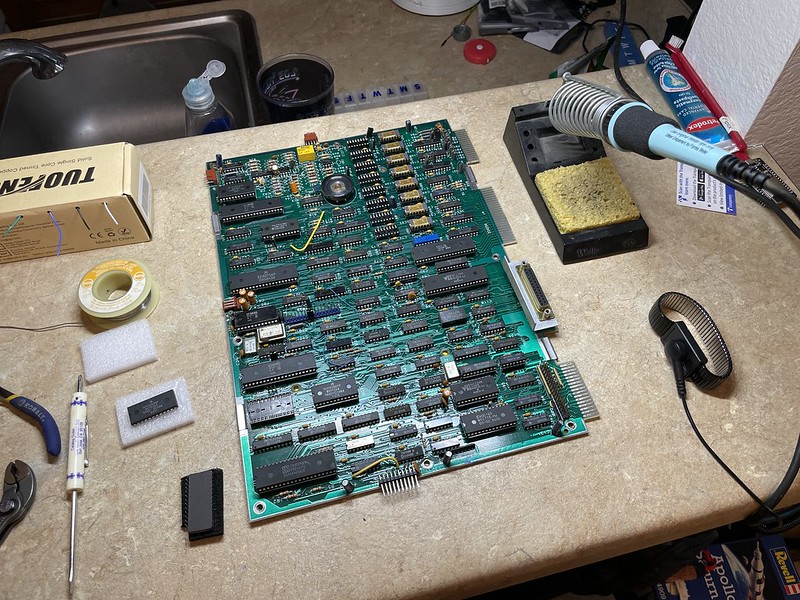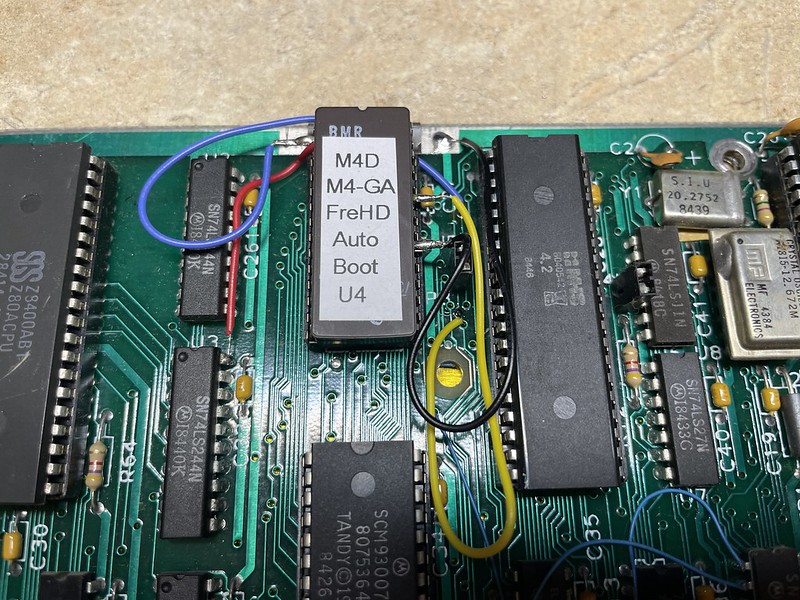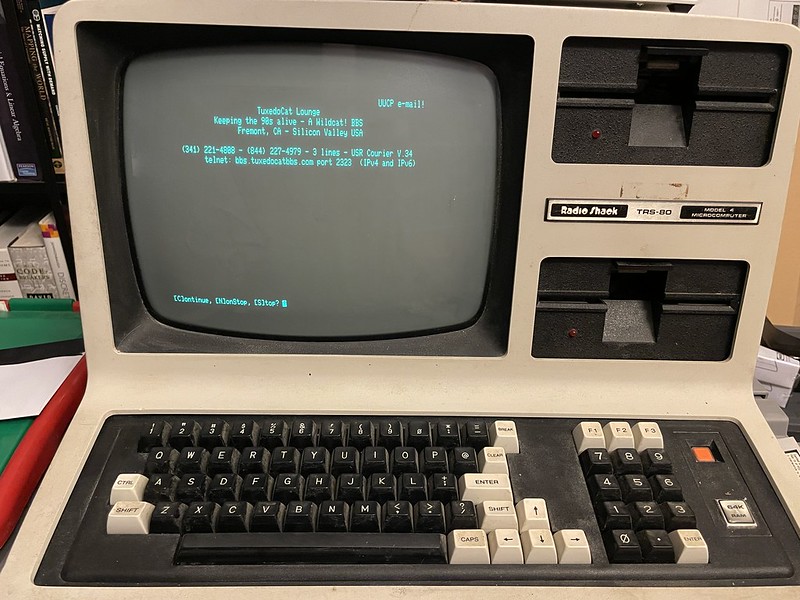I wound up buying a completed FreHD kit for the TRS-80 model 4, along with the self-booting EEPROM. FreHD is a TRS-80 hard drive emulator that plugs into the I/O connector on the bottom of the system. Normally the TRS-80 hard drives required a DOS to be loaded off of a floppy disk first, then the volumes were accessible. My floppy drives are still inoperable, so going this way lets me run programs on it in the meantime.
I didn’t realize it at the time but the EEPROM requires some wires to be soldered to it and to some spots on the system board. It works by replacing the casette BASIC ROM (U4) with the new EEPROM which contains the bootloader. I’m ok with soldering a little, but this required a couple of connectors to wee size pads on the circuit board. Fortunately nothing destructive like trace cutting needed to be done, so I was ok with trying it. God bless jeweler’s magnifying headsets, my eyes can’t see this tiny stuff well anymore. Fuck getting old.
I got it all together without any disaster:
As I was getting ready to put things together I noticed the I/O edge connector isn’t keyed nor does it have any numbers. Which way does the ribbon cable connect? The manual’s schematics didn’t have any numbering either, but did show all the pins on one side were all connected to ground, and the pins on the other side were connected to other components. Looking at the system board, on the component side, there’s a trace that connects every pin. I finally concluded the “even” pins 2-50 are all the grounds, and “odd” pins 1-49 are signal. So, the leftmost is pin 1 and rightmost is pin 50.
I put the system board back in, buttoned things up and fired it up. After an initial reboot the FreHD LED lit up and the FreHD loader menu popped on the screen. Success! First try!
Learning TRS-80 software
The FreHD SD image comes with several instances of LS-DOS, CP/M, NEWDOS, and various utilities on them. After poking around at different games and programs, I realized the TRS-80 is a much more capable system than I remember. In fact I don’t know much at all about the platform. When I was a kid the extent of my usage was booting TRS-DOS, loading BASIC, going to a long sheet of paper that had a list of BASIC games that were copied from who knows where, LOADing them and running them. I wrote some little BASIC programs, that was about it. We didn’t have hardly any commercial titles, I think just Superscripsit, VisiCalc, and Chicken! (The Superscriptsit did have an audio tape tutorial that taught me about proportional fonts!)
Most importantly I’m happy the thing actually runs software without crashing. Other than the video RAM issue, so far I haven’t seen any corrupted RAM, janky video, janky keys, or lockups.
The games on the system were popular names, if not knockoffs of arcade games. Frogger, Missile Command, Moon Rover, Breakout, etc. They were not some public domain BASIC programs either, they were real titles with real graphics and gameplay. Funnily enough most TRS-80 software seems to have no concept of returning to DOS, you have to hit the o’ orange reset button to get out.
Modem on the TRS-80
I found a couple of comm utilities such as Modem-80 and FastTerm II on the system so of course I had to try hooking up a modem, in this case one of my USR Couriers. First thing I had to do was track down a set of gender changers to go from DB-25 off the TRS-80 to my various DB-9/DB-25 cables to the Courier. The first app I tried was Modem-80. At first I could tell from the LEDs it was communicating with the modem but it wasn’t returning anything. I rigged up a null modem cable to my laptop and verified I could send type stuff on one system and see it on the other. I finally realized the TRS-80 wasn’t raising DTR, so I flipped a DIP switch on the Courier to always assert DTR and I was able to speak to the modem. I don’t know if this was because I wasn’t using a DB-25 to DB-25 cable or not.
I ATDT’d the BBS, lo and behold I got the Wildcat! banner and my login screen!
The ANSI color and graphics understandably didn’t work, but the rest did. 9600 bps seemed to be a bit too fast for it to keep up with as it griped about overruns occasionally. I had problems getting my modems to run at 2400 bps, so I settled at 4800 bps and it was decent. FastTerm II looked interesting too, of note it supported the Ymodem protocol. I found out there are other terminal emulator programs that say they support ANSI something, I need to figure out how to copy them over to the FreHD SD card and see what they do.
Floppy drives still vex me
I thought I might be able to copy Floppy Doctor over to the SD card and use it to work on the floppy drives. Then I read the manual for it and apparently it was released on a self-booting disk that TRS-DOS couldn’t read. Then I just found what looks like maybe an older CMD version, so we’ll see.
With the system booted I tried accessing the TRS-DOS disk I made. The drive would spin and seeks a bit, pause, and then come back with some error like “No disk” or directory not found or something like that. I’m still pouring over the VCF forums for ideas what to try. One thing that looks promising is to write 0x2F to a known track and then use some BASIC to seek the drive to that track and try to read, which should help sort out if the read head even works or if it’s even remotely aligned. I got my oscilloscope the other day, so I’m eager to poke some digital signals!
I do want to get at least one floppy drive working, as I have a few dozen TRS-80 floppies I want to go through.



